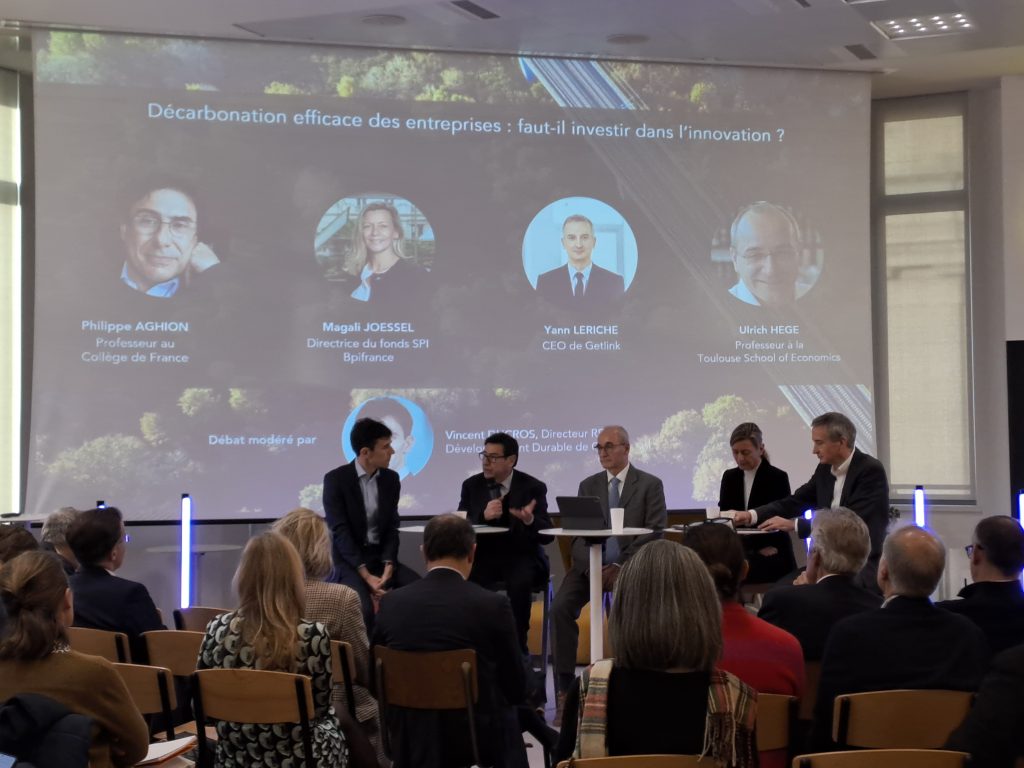Effective decarbonisation of companies: should we invest in innovation?
For the 4th edition of the Climate Talks, Getlink brought together Yann Leriche, Magali Joëssel, Director of the SPI Fund (Industrial Project Companies) at Bpifrance, Philippe Aghion, economist and Professor at the Collège de France, and Ulrich Hege, Professor at the Toulouse School of Economics, to discuss the role of innovation in financing the climate change transition.


In his introduction to the debate, Yann Leriche highlighted two key levers for corporate decarbonisation:
- Volume Lever: Quotas regulated by public authorities to limit corporate emissions.
- Price Lever: The carbon tax based on the polluter-pays principle, relying on a carbon price.
To these two levers, Philippe Aghion adds a theory indicating that they are not sufficient to achieve the climate transition: we need innovation as an acceleration factor for the transition.
This innovation lever, unlike the other two, is in the hands of companies and is not imposed by public authorities.
The necessary orientation of corporate actions towards innovation to counter path dependency in the fight against global warming.
Philippe Aghion reminded the audience during the debate that the orientation of companies towards green innovation is crucial to succeed in the climate change transition. In fact, the economist has conducted research and found that “actors who have massively invested in combustion engines in the past tend to continue innovating in this type of polluting technology.” This is what he calls “path dependency”, which means that an economic actor tends to spontaneously do what it already does. Therefore, it is essential for the State to direct investments towards breakthrough green innovation because if nothing is done, companies will spontaneously continue their investments in historically polluting technologies. The gap between these technologies and green technologies will continue to widen, and the climate transition will be ultimately more expensive. Finally, the economist notes that “young companies, which are not dependent, in the sense of path dependency, are driving the climate transition.”
To accelerate investment in innovation, Philippe Aghion mentioned several incentive levers to be activated in parallel: the carbon tax to reduce emissions and strong financial support from the State, similar to the Inflation Reduction Act (IRA) launched in the US in 2022.
Investor interest in climate innovation
And investor interest is there! Ulrich Hege notes that innovation patents for climate change have a return on investment of around 2% and that the market recognises the strategic value and distinguishes the quality of patents. The social impact is also significant: Ulrich Hege mentions a social return on climate innovation that is five times higher than the return on private investment, while for other innovations it is closer to 2.
Long-term support for businesses and the necessary structuring of sectors
Magali Joëssel recalled the mission of Bpifrance, which provides financial support to two types of companies: companies that are helped to decarbonise their activities and “solution providers” that innovate. Over the last 10 years, investment in the green transition has increased from €700 million in 2013 to €9 billion today.
The typology of investment has also evolved, with the State now prioritising certain sectors or technologies, such as hydrogen, by massively subsidising technological research in this sector. Public policies are fundamental to structuring sectors, but this cannot be done without economic actors. It is necessary for all actors in the same sector to cooperate with each other and not just to be in a logic of simple competition. Several forms of cooperation have been mentioned, such as cooperation in research and development or innovative purchasing, whether public or private.
At Getlink, world firsts to be ever more low carbon!
Yann Leriche presented the innovative low-carbon projects launched by the Group, such as the ongoing project to install solar panels on the Eurotunnel terminal to develop a world first: power to traction, i.e., using the solar energy produced on the terminals to power the trains in operation.
Other “green” innovations have also been completed by the Group, such as the ElecLink high-voltage cable in the Tunnel or Track Value, a solution for digitising the tracking of rail freight.
The decarbonised margin created by Getlink in 2023 is also an accelerator for transparency on the reality of effective corporate climate action. In this respect, it creates the link between climate and financial performance.
Yann Leriche returns to the concept of path dependency. Getlink is innovating to reduce its greenhouse gas emissions and, of course, investing in its core business. However, in order to achieve carbon neutrality, the group relies on other actors to develop innovations that will allow it, for example, to eliminate carbon in a sustainable way. Today, there is not enough support to encourage innovation in this area.
Yann Leriche also agrees with Magali Joëssel’s observation that in France, sectors are underdeveloped and there is a lack of real collective structures for climate innovation, for example on carbon capture.
At the end of the meeting, Yann Leriche therefore called for the pooling of resources: the creation of a collective to work with external partners to develop innovations in favour of the climate transition.



